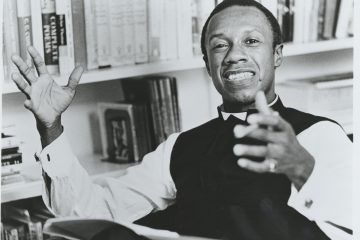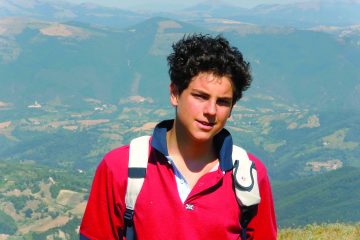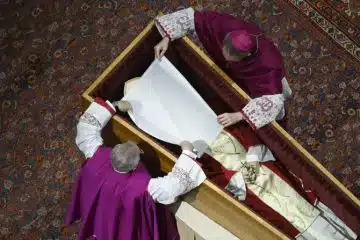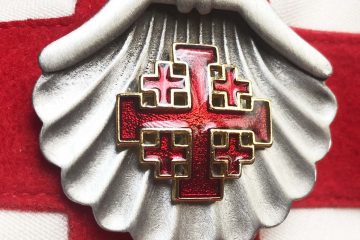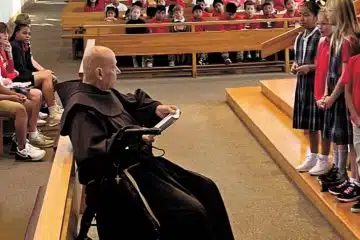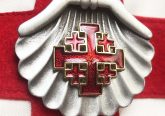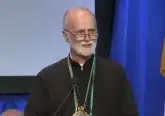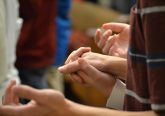Twinning relationships enhance concept of mission
September 26, 2011
By Eileen Connelly OSU
ARCHDIOCESE — According to the “Guide for Parish Twinning,” which originated in the Diocese of St. Cloud, Minn., and has been adapted for use by the Archdiocese of Cincinnati, the term “mission” has traditionally meant going forth into the world to teach the Gospel of Jesus Christ.
 |
| Neil Diller of St. Peter Parish in St. Peter and Tim Barman of Mary Help of Christians in Fort Recovery ride a truck with Guatemalan locals after work on a project. (Courtesy Photo) |
For the archdiocesan faith communities involved in twinning (or sister) relationships with parishes and groups within or outside the United States, there have been opportunities for mission or missionary activity that have included assisting in health clinics, tutoring children and collecting items to be sent to the needy.
Such efforts are and will continue to be important, noted Mike Gable, director of the archdiocesan Mission Office, but there is also much more to parish twinning relationships. Those involved in such partnerships are called to rejoice in their diversity, gain greater understanding and love for each other and celebrate their oneness in the body of Christ.
As the guide states, “Mission is a process of mutual self-giving and receiving for and with others, as modeled in our triune God of Father, Son and Holy Spirit, who invites us all into His communion of boundless, self-giving love. We become missioners when we respond to God’s gifts to us by putting those gifts to work in building right relationships with others, creating local and global communities in which mutual sharing of gifts allows each person to be the unique person s/he is, while at the same time, contributing to the whole. Such relationships commit us to transform our diocese and our world into the reign of love, justice and peace of Christ.”
Among the faith communities in the archdiocese with a strong, long-term sister relationship is Immaculate Heart of Mary (IHM) Parish in Anderson Township, which has twinned with the Cultural Center of Batahola Norte in Nicaragua since 2000. The community center in Managua offers music and art classes to children, scholarships to the college bound and practical skills training for adults. Its priority is to work with the women and children who are most oppressed by social and economic inequity, break the cycle of poverty, empower the community and restore hope.
As of this past June, 159 adults and youth from IHM have visited the center, said Sue Keefe, an IHM parishioner who chairs the twinning relationship. Several visitors from the center have also traveled to the Cincinnati area each year. The parish supports the center through activities such as an annual garage sale, student sponsorships and the collection of shoes and backpacks for children there by students from area Catholic schools.
The true meaning of the relationship, though, lies in what the visitors from IHM have learned from their twinning partners a world away. “They have such faith in God and such hope,” said Keefe. “It always amazes people when we go to visit that they share their faith so willingly.”
Rob Hiltz, who served as a chaperone on this year’s trip, spoke of how IHM has been blessed by the relationship, saying, “Having the opportunity to visit the Batahola center classrooms and break bread with the students and staff, I left with a feeling of special blessing — that sense of gratitude. I’m not referring to the people of Batahola thanking IHM parishioners for our support. Certainly they do appreciate and thank us for what we send to them, but more importantly, the students and staff are very grateful for what little they have. There is a deep sense of hope that comes with the opportunity for a better tomorrow, with the opportunity to learn and grow. There is a notion that we are all truly connected and that we, as distant strangers, extend assistance to teachers and students and that it is then passed on to others. There seems to be a deep appreciation for blessings that come from God through these relationships.”
“As we visit and depart Batahola, we learn that we should all be grateful for whatever gifts we have been given from God and that the reward might just be in our gratitude and not necessarily in the abundance,” he added.
That same sense of blessing and gratitude has also been experienced by the Fort Recovery Cluster in its twinning relationship with a parish in La Labor, an impoverished community on the outskirts of Guatemala City. Parishes in the cluster — St. Joseph in St. Joseph; St. Peter in St. Peter; St. Paul in Sharpsburg; and Mary Help of Christians in Fort Recovery, along with St. Anthony in St. Anthony — have worked with the Guatemalan faith community for 13 years. Precious Blood Sister Margo Young, a medical doctor, helped establish the connection with La Labor, which includes several health clinics and a school.
Neil Diller, who coordinates the cluster’s mission effort, said the twinning relationship originated with parishioners’ desire to “do something outside of ourselves. We’re farm people. That’s our heritage,” he said. “We’d rather do things than just look.”
Critical to the success of the cluster’s partnership with the faith community in La Labor have been regular visits and the resulting “connectivity” with the people there, many of whom live in small shacks with dirt floors and no windows, Diller said. Unemployment and limited educational opportunities are also issues. In response, the cluster has raised funds to provide stipends for teachers and scholarships for students, along with assisting in the health clinics and engaging in various maintenance and building projects.
“It’s good to be doing something for people in another part of the world, but we end up getting more out of the relationship than they do,” Diller said. “It’s really a trick on you. You think you’re going there to help, but when you leave, you’re realize you’re the one who has benefitted. We’ve developed relationships and have come to realize we’re no different than them. It has helped give meaning to our faith, helped our faith come alive.”
The same holds true at St. John the Baptist Parish in Harrison, which twins with Santa Cruz Parish in El Salvador. The relationship developed in 2002, when Deacon Don Meyer’s son, TJ, was serving in El Salvador as a Maryknoll lay missioner.
Deacon Meyer and wife, Kathy, traveled to El Salvador and Honduras as part of a trip sponsored by the Mission Office to promote twinning and visit missioners from the archdiocese. While in El Salvador, the group met Maryknoll Sister Terry Alexander, who introduced them to the pastor and people of Santa Cruz Parish.
“We were deeply impressed by their faith,” Deacon Meyer recalled. “It seemed like a good connection.”
That connection has deepened over the years, with groups from St. John the Baptist Parish traveling to El Salvador annually and visitors from there coming to Cincinnati every three years. In 2005 the parish established a sponsorship program for Salvadoran school children, but Deacon Meyer stressed that the relationship goes much deeper.
“What we gain is a much stronger faith, strengthened by the faith of those who have struggled so much in the face of poverty and oppression,” he said. “A relationship with El Salvador isn’t a hammer and nails thing. It’s living out the universality of our faith. We walk together as brothers and sisters, sharing our faith, our joys and our struggles. We pray, we laugh and we eat together. We become one. I think that’s what Jesus wanted.”
It was two immersion trips in 2005 that led to the partnership between Corpus Christi Parish in New Burlington with St. Vincent Strambi Church and School and the St. John Bosco Boy’s Home in Jamaica. Since then, said Deacon John Corson, there have been six mission trips to Jamaica during which the Cincinnati visitors have built houses, painted classrooms, laid floor tile, visited the sick, visited nursing homes and orphanages and helped the children with their school work.
“It’s always such a blessing when we go there,” Deacon Corson said. “It’s not just about the work projects. It’s about truly being with our brothers and sisters.”
He recalled one elderly Jamaican woman who eagerly greets travelers from Cincinnati by reaching out to touch them because she is blind and yearns for that physical contact. Then, there was the cancer patient who couldn’t receive Communion due to an ability to swallow, yet was still grateful for the presence of bedside visitors.
Walking in the shoes of their twinning partners, living with them and working alongside of them has given Corpus Christi parishioners a greater sense of “who we are as God’s people and that God’s people are everywhere,” Deacon Corson said. “It’s a way for us to thank God for all of the gifts we have received.”
Area parishes have found twinning relationships with partners in the United States to be just as meaningful. St. John the Baptist Parish, for example, also twins with Holy Cross Parish in Jackson, Ky. On visits there, teams from the faith community may help elderly or disabled residents repair or update their homes or engage in other projects. Located in a region that’s primarily Baptist, Deacon Meyer said the trips are “a real evangelization tool and an opportunity to live out our faith. They know we are Catholics by our love,” he said. “A great part of the experience is also just being with the people and hearing their stories and learning about each other.”
In 2010 IHM signed a covenant to twin with Our Lady of the Mountains Parish in Stanton, Ky. Located in Powell County, the third poorest county in Kentucky, the parish is known for its outreach to the poor in an area where resources are limited. On their visits, IHM parishioners have brought items for the local food pantry and visited residents at the nearby nursing home.
“It’s been a wonderful way to share our faith and connect with others,” Keefe said. “Not everyone wants to, or is able, to travel to Nicaragua.”
Corson said that in addition to the relationship in Jamaica and numerous local ministry efforts, the Mission Outreach Commission at Corpus Christi is exploring avenues through which they may be able twin in the United States.
“We keep the mission concept in front of our parishioners in so many ways that it has permeated the whole parish and we want to continue that,” he said.
In recognition of the Archdiocese of Cincinnati’s twinning and other mission efforts, Maryknoll Magazine and Revista in New York will be sending reporters, along with a photographer, to the area Oct. 17-24 to interview Archbishop Dennis M. Schnurr, retired Archbishop Daniel E. Pilarczyk and a variety of others connected with immersion trips, volunteer opportunities broad and other solidarity projects.
“They told me they are coming to our archdiocese because they believe we are a great model that other dioceses should consider to promote mission and solidarity,” Gable said.
Marykoll leadership has also invited the Mission Office to help them design a twinning effort for dioceses across the United States as part of a new effort to enliven mission, Gable added.


